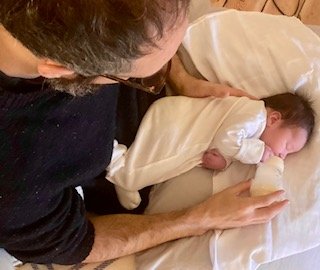Paced or responsive bottle feeding
How to offer a bottle to a breastfed baby
Remember, for a baby, breastfeeding isn’t always about the milk, it can also be a way to soothe and settle along with having a lovely cuddle.
Giving a bottle should mimic this as much as possible, building trust and confidence. It may take time for your little one to learn the new techniques they need to bottle feed, so try to be patient with them. Introducing a bottle can be a slow process and takes some babies longer than others.
It can be helpful to start when your little one is calm and not too hungry.
Some times its nice to introduce this new skill after, or even in the bath (if bathing with you). Its important that your baby feels safe and that they are able to be in control and welcome the teat into their mouth. Make eye contact with them and gently talk and reassure them. Equally, if they are not keen, respect that, and try agin another day. Some babies need to get used to seeing and feeling the bottle before they begin to drink any milk from it. Simply welcoming the teat alone on a clean finger can be a nice introduction for a sensitive baby.
When you are offering a bottle, you want to help your baby to keep opening their mouth nice and wide, the way they do when they are latching on to the breast.
To do this with the bottle, you can gently and slowly stroke the teat from their nose down to their upper lip to encourage them to open their mouth nice and wide. Follow their lead when they are exploring the bottle, let them lick and play with the teat. If at first, they try to push it out of their mouth with their tongue, let them, and then offer it again at their lips so they can open their mouth and latch on if they want. As your baby becomes more confident, they will take the bottle into their mouth and start to suck. When they make the association between the bottle and milk coming into their bellies, they will often be happy to take it.
Responsive feeding is always recommended when offering a bottle, as it helps a baby to regulate and respond to their appetite.
When a baby is held in the traditional, reclined bottle feeding position, a combination of gravity and the baby’s sucking reflex means it is easy to persuade them to drink more milk than their tummy can comfortably hold.
As a society we don’t like waste and really like quantifiable numbers, so please don’t feel like your baby should finish everything!
This can put them at risk of overfeeding, and having a tummy ache. When offering the breast and bottle (mixed feeding) it can also confuse them and give them a preference for a fast flow, which may mean that they begin to reject the breast, which usually has a much slower and more varied flow. Pacing a feed is important whether you are giving breastmilk or formula in a bottle, and helps a baby to drink more comfortably, regulate their own appetite, have less wind and be less confused by the different feeding methods. Everyone has a slightly different style to giving a bottle, so when your little one is learning, its best if one of two trusted people offer it, until they become more accustomed. If you are breastfeeding, it may help if your partner offers the bottle.
The beauty of paced or responsive bottle feeding is that your baby will be able to indicate when they are full much more easily.
It is very important not to try to coax your baby to drink more than they can comfortably fit, or their ability to self-regulate might be impacted, putting them at risk of being overweight and future obesity. Watch your little one for signs or cues that they have had enough or need a break, like splaying their fingers or toes, furrowing their brow or turning away and spilling milk out of their mouth. If they do, gently lower the bottle downwards to cut off the flow of milk and wait to see how they are, all babies will be different, just like us. We do not eat the same quantity at each meal and we shouldn’t expect our babies to either, a range of amounts across the day is quite normal.
Babies have evolved to be in close contact with their mothers and need to be fed frequently day and night.
A newborn has a very small stomach capacity that can hold around 5-7ml per feed. The total volume a baby may take in the first 24 hrs is around 37ml
By day 3, a baby’s stomach can hold around 22 -27ml per feed and may take around 220ml in 24hrs
At one week of age a baby’s stomach can hold between 45-60ml per feed and the average daily intake is between 280-576ml depending in the baby’s size and weight.
From between 4 weeks and 6 months, your baby’s maximum stomach capacity is around 80ml-150ml per feed, with the total daily volume being between 600-900ml or around 25oz in 24 hours
Most babies require roughly 150-200ml of milk per Kg per day until solid food is introduced at around six months of age. Small frequent feeds are normal as well as night feeds.
What type of bottle?
The type of bottle and teat you use is not as important as making sure that whoever is feeding your baby always practises paced bottle feeding.
It is easier to practise this with a bottle and teat that is not too big or too wide.
Look for a bottle that has around a 150ml maximum capacity, and as my colleague Kathryn Stagg says ‘ one that resembles Kate Moss in shape rather than Beyonce’. This type of bottle is more suitable for paced bottle feeding as the teat can easily fill with milk when the bottle is held in a horizontal position. The type of teat and bottle that need to be inverted to fill the teat are less suited to responsive feeding. Its also a good idea to look for a bottle that is easy to clean, without anti colic bags or extra components. Pacing the feed and being responsive to your babies cues and signals is what will help your baby to feel safe, control the flow and prevent excessive wind, not the addition of extra hard to clean equipment.
Try to choose one style of bottle and stick to it as every bottle will feel a little different in a babies mouth and they will need to relearn with each one. Teats will also need replacing regularly with use.
How to pace a feed
Hold your baby close in a semi-upright position so you can see their face and reassure them by looking into their eyes and talking to them during the feed.
If you are giving more than one bottle a day try and alternate the side you hold baby just like with breastfeeding, as this helps to encourage equal physical stimulation.
Begin by inviting them to open their mouth by gently stroking their top lip with the bottle teat.
Allow them to welcome the teat and organise their sucking pattern before they get any milk.
When they are happily sucking slowly tilt the bottle up to a horizontal position (just slightly tipped) to prevent milk from flowing too fast.
Its good to give a baby the opportunity to pause every 30 seconds or so by dropping the bottle down so that the milk no longer flows.
You don’t need to take it out of their mouth and can continue by raising it again to vertical when they show signs that they are ready for more.
Stop when they loose interest or show signs that they are full or need a break.
They may not always drink everything in the bottle at each feed, sometimes they may want less and sometimes you may need to add more.
My Colleague Stacey Zimmels an IBCLC and a speech and Language practitioner has written a great blog around the elevated side lying position.
I find that I am teaching my clients this a lot more and that they are finding it really useful.
It’s a lovely calm way to support a baby and offer a bottle. Laying on their side means that they don’t use excessive energy sitting up and often it is a lot more comfortable for parents. It can also be very beneficial to a a baby with reflux or colic like symptoms, especially if they are laying on their left side as their stomach has more space to digest.
You can even feed twins in this way.
If you are using expressed milk in a bottle, start with a around 20/30 ml so as not to waste too much if they don't take it. If you are in the bath with them, not only will it help to warm the bottle and milk, but will also be a lovely bath tonic if there is any left: breastmilk is great for the skin. As they get used to bottle feeding you can add in more milk.
Aim to keep it playful and light and stop if you, or they become anxious, no one appreciates learning a new skill under stressful conditions and this is something that you want to all enjoy.





